The Barbarossa class battleships were the first modern pre-dreadnoughts, capital ships of the Ottoman Navy, named respectively Hayrediin Barbarossa and Turgut Reis. These were the ex-Weissenburg and Kurfürst Friedrich Wilhelm, which after years of service were no longer relevant and considered obsolete in 1910. The Turkish Ottoman government purchased, carefully planned and worked out by the German military attache allowed to secure some cash while giving the Turkish Navy a way to re-establish the balance after recent Greek purchases, notably the Giorgios Averoff.
They were named, for the first after the most famous admiral which secured Ottoman dominance of the Mediterranean in the 16th Century, and the second after the other admiral which extended this dominance to across North Africa. After they took their first commission, the balance indeed leaned towards Turkey again. Both ships became quite active and had a fairly long career compared to the first two sister-ships of the Brandenburg class, Brandenburg and Wörth.
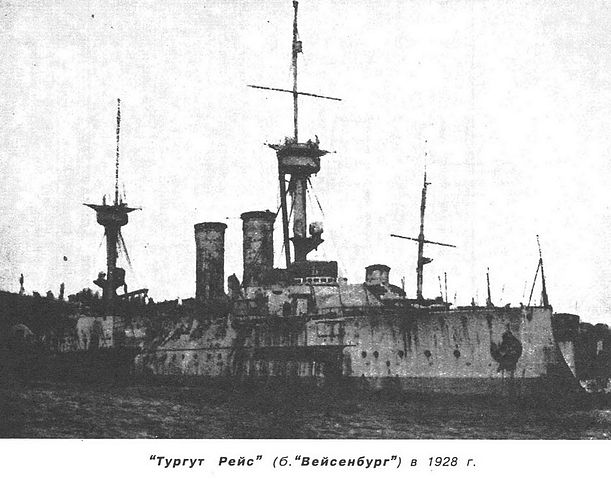
NRP Torgut Reis in 1918
Previous history and purchase
The Brandenburg class has been Germany’s first true battleships. They succeeded to a serie of six much smaller armoured coast defence armored ships, named after Norse gods. They were a symbol of the will of the new German Empire, united since a mere twenty years, to assert itself as the dominant naval power of the Baltic. The four ships of the class inaugurated a serie of “first” for Germany, and entered service in late 1893, conducting sea trials until 1894.
They showed many teething issues like propulsion machinery requiring lengthy repairs, boiler explosions, faulty valves. These problems showed the value of a careful manufacturing mastery and post-production quality checks. These errors were never repeated in the next classes. These battleships saw extensive service, including the Boxer Rebellion in 1900. From 1907 they entered the reserve squadron, underwent some overhaul, and stayed in reserve in 1911. Brandenburg and Wörth took part in the Vth BS squadron affected to coastal defense duties on the north sea. From 1916 both ships were disarmed and the guns converted to railways and sent to the western front.
SMS Kurfürst Friedrich Wilhelm in service
Kurfürst Friedrich Wilhelm and Weissenburg also had some intensive service before 1910. The first spent her early career mostly in the Baltic, visiting western ports after crossing the Skagerrak strait from May 1899. She visited Falmouth, went as far as the bay of Biscay, and reached Lisbon. She also participated to the naval review celebrating Queen Victoria’s 80th birthday. Like her sister ship of the I Division she was deployed in China during the Boxer rebellion.
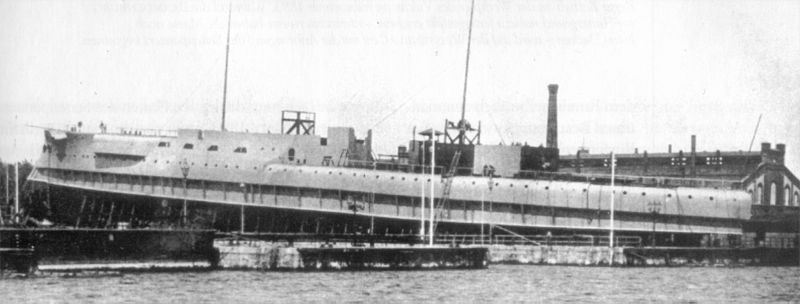
By that time she was part of the German East Asia Squadron, which consisted of the protected cruisers Kaiserin Augusta, Hansa, Hertha, and the small cruisers Irene, Gefion, and gunboats Jaguar and Iltis. She was soon joined by the three other ships of the Brandenburg class, six cruisers, 10 freighters escorted by three torpedo boats, landing six regiments of marines. She blockaded the Yangtze River.
Back in Germany, after a refit in 1902-1905 and a period of exercises she became the flagship of the Cuxhaven reserve squadron which also comprised the coastal defense ships Ägir and Frithjof, the minelaying cruisers Nautilus and Albatross, and the avisos Blitz, Pfeil, and Zieten. She made manoeuvres with the Hochseeflotte, returned and then re-emerged from reserve in 1909.
SMS Weissenburg in service
SMS Weissenburg had a relatively similar career, with I Division until 1900, with training exercises and goodwill visits. These exercises were especially important and were made under the watchful eye of Alfred von Tirpitz, the great architect of the fleet. Weissenburg also went to China with her sister-ships in 1900–1901 (Boxer Rebellion). She was thoroughly reconstructed and modernized, albeit at a prohibitive cost, in 1904–1905 at Kaiserliche Werft.
Her career of exercises in the Baltic resumed, she damaged her ram bow which was repaired, and served until 1909 when she was placed in reserve. She was decommissioned on 29 September 1907, formally with the Reserve Formation. She was reactivated in the summer of 1910 for another exercise conducted her and her sister-ship to Turkey after her purchase.

The purchase, to form the Barbarossa class
By late 1909, the German military attaché to the Ottoman Empire started a discussion with the Ottoman Navy staff about a possible sell of some Brandenburg class warships, in order to counter the recent Greek naval expansion. Negotiations went for months, back and forth, whereas the Ottoman Navy staff tried to purchase one of the Von der Tann class ships. The Germans on their side wanted to sell the entire Brandenburg class, at 10 million marks.
Eventually the option of purchasing the Weissenburg and Kurfürst Friedrich Wilhelm only was based as they were the most recent of the four. This limitation was both a cost-saving measure and reflected the sign Greek expansion seemed closed at that point. The two battleships were renamed and officially transferred on 1 September 1910 and 12 September respectively. The German Reichsmarineamt struck them from the naval register retrospectively on 31 July.
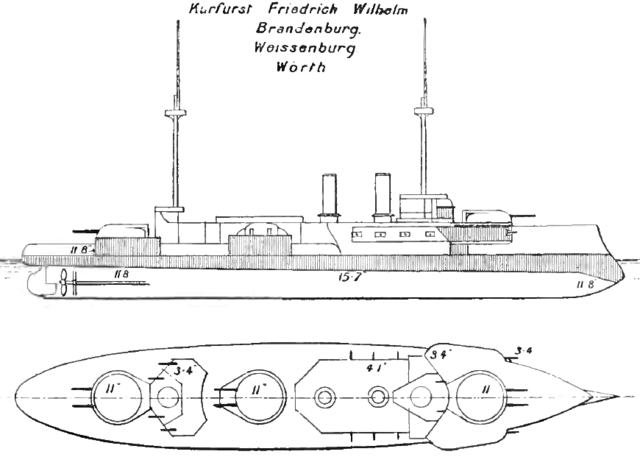
The Ottoman Navy received the Barbarossa class battleships with German crews that travelled on them, but the latter soon departed back to Germany, leaving the Ottoman Navy crewing the ships with hasty formed recruits. Having no proper cadets academy, the Navy was forced to recruit on other ships, somewhat crippling the capacity of the fleet for some time. The lack of proper maintenance also quickly showed up. These ships suffered from condenser problems and were forced to sail at 8 to 10 knots (15 to 19 km/h; 9 to 12 mph) in manoeuvres.
Design of the Barbarossa class battleships
As designed, the Barbarossa class ships displaced 10,013 t (9,855 long tons), and 10,670 t (10,500 long tons) fully loaded. They measured 115.7 m (379 ft 7 in) overall for a beam of 19.5 m (64 ft) and 7.9 m (25 ft 11 in) draught. Just before the Boxer war they received wireless telegraphy sets, the first German ships fitted with this system.
Powerplant
They had machinery consisting of two screw propellers connected to two shafts mater on triple-expansion steam engines, fed by the steam produced by 12 Scotch marine boilers. The ensemble was rated for 10,000 metric horsepower (9,900 ihp), enough on paper for 16.5 knots (30.6 km/h; 19.0 mph), also this was quite reduced by 1910, even after the refit. Their range was 4,300 nmi (8,000 km; 4,900 mi) at 10 knots (19 km/h; 12 mph). Their crew consisted of 38 officers and 530 enlisted men.
Armament of the Barbarossa class battleships
Both ships were armed with three twin turrets, including two with 28 cm (11 in) MRK L/40 caliber Krupp guns, and the central turret with two 28 cm (11 in) MRK L/35 caliber guns. The idea was to reduce the overall length of the barrel to allow a better firing arc in this central position.
These main guns were unique, only done for this class. The mixture of L/35 and L/40 guns was also allowed by the absence of a centralized fire control.
The guns were built from hoops, using a horizontal wedge breech mechanism and placed on mountings using hydraulic power and steam pumps. However the breech mechanisms was man-handled as well as the ramming. The weight of the 28 cm ammunitions still allowed this. The true bore was 28.3 cm (11.1″). Each gun was 44 tonnes, 11 m in length, with a chamber volume of 8,723 in3 (142.9 dm3) and average rate of fire of one round every two minutes. 60 rounds were provisioned for each gun so 360 in all, fired at a 2,690 fps (820 mps) muzzle velocity. The bag-charge projectile could be either an AP round L/2,6 2 of 530.7 lbs. (240.7 kg) or the HE L/2,9 529 lbs. (240 kg) varying 76-82 cm in length.
The original secondary armament comprised eight 10.5 cm (4.1 in) SK L/35 guns and the light armament eight 8.8 cm (3.5 in) SK L/30 naval guns and six 45 cm (17.7 in) torpedo tubes for close quarters.
-The 10.5 SK L/35 were a bit light compared to the British 6-in or French Canet 164 mm, but widespread in the fleet and was a pure Schnelladekanone, or quick-firing gun. This 10.5 cm/35 (4.1″) SK L/40 only used on the Brandenburg class used an horizontally sliding breech mechanism. Each gun measured 3.6 m and weighted 1,270 kg. The rate of fire on paper was ten, reduced in average to 6-7 with a well trained crew. After modernization, this gun was given the unique 1907 HE round weighting 47.2 lbs. (21.4 kg).
It is assumed that alongside, the older 1891 AP weighted 40.1 lbs. (18.2 kg) was also available. The propellant charge was the 6.24 lbs. (2.83 kg) RP C/06. Muzzle velocity was 2,034 fps (620 mps) for the 1891 AP shell and 1,968 fps (600 mps) for the 1907 HE model. Each gun was assigned 145 rounds. Originally the torpedo tubes were on above-water swivel mounts. During their first service modernization, the anti-torpedo defence was bolstered by four 3.7 cm (1.5 in) Maxim guns installed in the fighting tops. They had an average rate of fire of 33 rpm.
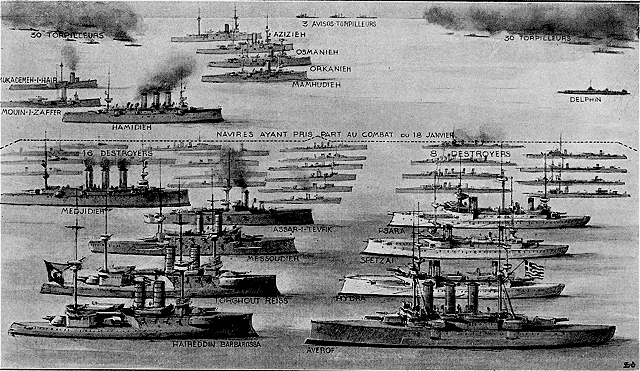
Armor protection of the Barbarossa class battleships
The Belt was 400 mm (15.7 in) thick, way above any caliber of the time, and also as a defence against torpedoes. The main gun barbettes walls were 300 mm (11.8 in) thick backed by 210 mm of teak wood, while the armored deck was 60 mm (2.4 in) in thickness. ASW protection was also well done, with an enclosed citadel and internal bulkheads plus watertight doors with an automatic closing system. However the connection between the belt and deck of the citadel was effective only at deflecting short-range shells and could not have resisted plunging fire. The conning tower forward had 300 mm walls and a 30 mm roof.
The Barbarossa class battleships in action
Kurfürst Friedrich Wilhelm and Weissenburg became the Barbaros Hayreddin and Turgut Reis respectively but immediately suffered from chronic machinery problems. The main culprit was that the crews has not been trained to properly maintain the propulsion systems. In practice their effective speed fell to 8-10 knots on average (15 to 19 km/h; 9 to 12 mph). This allowed them to sail with the older Turkish modernized ironclads, but against modern adversaries, they were just too slow to manoeuvrer effectively. Their role was more to show the flag and make a form of deterrence towards Greece.
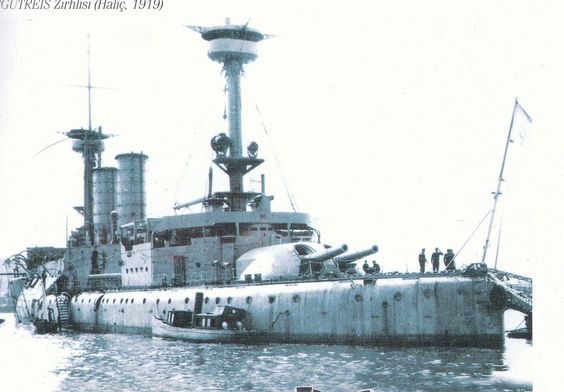
Italo-Turkish war 1911
This did not prevented Italy to cross swords with Turkey in War that broke out in September 1911. Knowing these limitations and the strength of the Regia Marina, of another order of magnitude than Greece, the Ottoman fleet safely stayed beyond the range of the Dardanelles fortifications. Neglect of the fleet during the conflict meant the ships were in even worse condition in October 1912. As reported by officers on duty, the telephone systems were out of service and most watertight doors unable to close. Worst still, the rangefinders and the ammunition hoists had been removed.
Balkan war 1912
Right after the Italo-Turkish War, the Balkan League declared war in turn on the Ottoman Empire, encouraged by Italy’s success and apparent ease. The Barbarossa and Turgut Reis this time were called to action to support at first Ottoman forces defending against Bulgarian troops in Thrace. In December 1912, the fleet was made into a task force charged to deal with the Greek Royal Hellenic Navy in the Aegean Sea. The Barbaros Hayreddin became the flagship of the division.
This fleet made a first sortie to try to lure the blockading Greek fleet out, which succeeded, leading to the Battle of Elli. In it the Greek armored cruiser Georgios Averof easily outmaneuvered the Ottoman squadron as it was feared. The Greeks effectively cross-fired it between the Averof and the three Hydra-class ironclads. The damage was considerable, and seeing there was no hope, the Ottoman admiral asked to retreated back to the Dardanelles. The Greeks then soon blockaded once more the entrance.
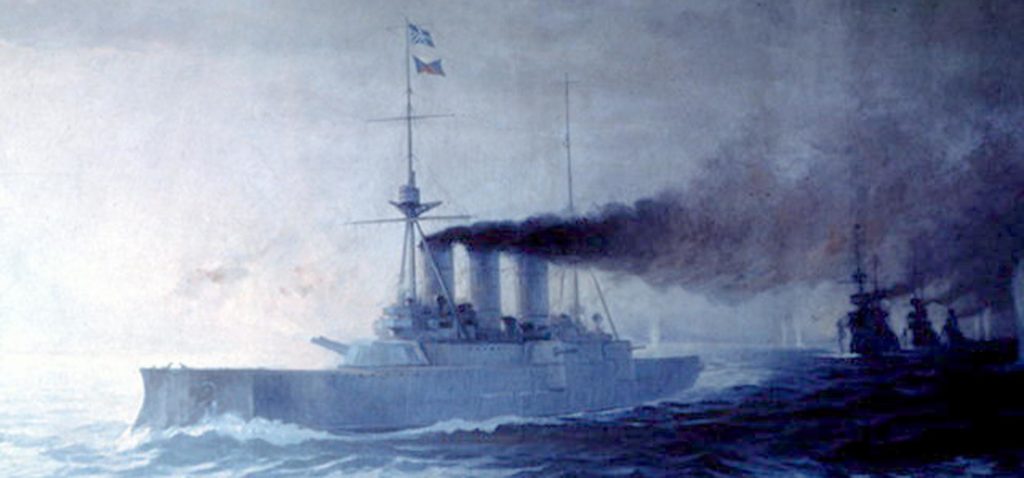
The battle of Elli, December 1912: Both battleships were crossed-fired by skilfully manoeuvring Greeks
There was an attempt to break the Greek blockade on 18 January 1913, resulting in the Battle of Lemnos. Barbaros Hayreddin and Turgut Reis again were copiously fired upon, taking many hits, but only took minor damage. They eventually withdrawn without achieving any result. For the rest of the war, the Ottoman Navy operated in the Sea of Marmora and Black Sea, against Bulgarian forces. They covered the Çatalca garrison through March 1913.
The battle of Lemnos
This last naval clash of the war resulted from an Ottoman plan to lure the Georgios Averof away from the Dardanelles. The cruiser Hamidiye was chosen for the task, as the fastest ship in the navy. She successfully evaded the Greek blockade, broke out into the Aegean Sea. It was assumed that the Georgios Averof would be sent to hunt her down but the Greek commander refused to detach his flagship and stayed still. Both Barbarossa class battleships participated.
By mid-January, and Ramiz Numan Bey, the fleet commander pressured by his hierarchy, decided to attack the Greeks anyway. Turgut Reis, Barbaros Hayreddin, and the rest of the Ottoman fleet left the Dardanelles at 08:20, 18 January. They headed for the island of Lemnos at 11 knots (20 km/h; 13 mph). Barbaros Hayreddin led the line with a flotilla of torpedo boats guarding the flanks, a lesson learnt from the previous battle.
Georgios Averof set sail, together with the three Hydra-class ironclads and five destroyers protecting their back, and intercepted the Ottoman fleet 12 nautical miles (22 km; 14 mi) from Lemnos. At 10:55, the cruiser Mecidiye spotted the fleet and the Turks turned south to face them.
The battle started with a long-range artillery duel which ended around 11:55, after which the distance fell to 8,000 m (26,000 ft). Both battleships concentrated their fire on Georgios Averof at 12:00. 50 minutes later, the Greeks manoeuvred to “cross the T” of the Ottoman fleet, but the latter, well led by a skillful commander, turned north and this failed. The Ottoman commander then detached the old Mesudiye seriously damaged, ordered to withdrawn.
Barbaros Hayreddin took serious hits and her speed fell to 5 knots (9.3 km/h; 5.8 mph), Turgut Reis took in turn the lead of the formation, but eventually Ramiz Numan Bey decided this was enough and broke off the engagement. One hour later, the Ottoman fleet was back in the shadow of the Dardanelles fortresses and the Greeks in hot pursuit withdrawn in turn. Both battleships spent 800 rounds, mostly from their main battery, but scored no hits. The barbettes of both battleships were damaged and disabled, while they had been ravaged by fire.
It seems obvious that the Greek gunners were certainly more skilled, but there are reasons why the Turks performed so poorly. Due to the lack of rounds, training was inexistent, and worst, the rangefinders of both ships had been removed, making quite a loss of accuracy. The ship’s 28cm compared on paper favourably to the four 234 mm artillery of the Averoff, which were in fact more recent BL 9.2 inch Mk X gun 48 calibers, completed by eight quick-firing 190 mm guns and state of art rangefinders with a well trained crew. This allowed this armoured cruiser to take on both battleships with ease.
From the war’s end to 1914
On 8 February 1913, the Ottoman navy was covering an amphibious assault at Şarköy. Both Barbarossa class battleships teamed up with two small cruisers, making this artillery support on the right flank, from a km off shore; Turgut Reis was placed behind Barbaros Hayreddin. The Bulgarian army fought hard but ultimately the Ottoman army was forced to retreat, always covered by gunfire from the fleet. Turgut Reis fired alone spent 225 secondary rounds and 202 light round (8.8 cm guns).
By March, both ships were in the Black Sea, resuming support of the Çatalca garrison, while under pressure and renewed attacks by the Bulgarian army. On March, 26, a fierce artillery barrage including 28 cm shells successfully repelling the Bulgarian 2nd Brigade (1st Infantry Division). On 30 March, the left Ottoman wing started to breakthrough and chase the retreating Bulgarians, and this was assisted all along by field artillery the fleet’s heavy guns, at extreme range. Thanks for good coordination, 1,500 m (4,900 ft) were taken by nightfall.
The Bulgarians came back with the 1st Brigade and fend off the Ottoman advance. They were back to their original positions On 11 April. The fleet then steamed to Çanakkale, so that the Barbarossa class battleships could provide efficient distant cover for a lighter light flotilla trying to spot Greek warships. The clash ended with an inconclusive engagement.
Barbarossa class battleships in the great war
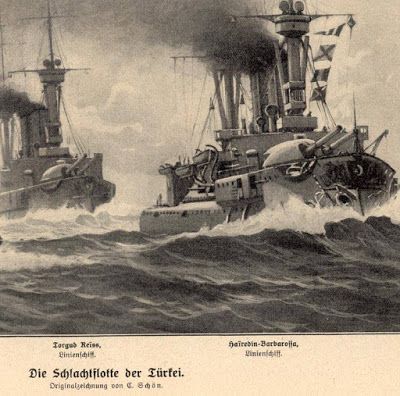
The Turkish fleet in a German wartime article Src
When in August 1914 the war broke out, the Ottoman Empire was neutral, for a few days, before a “gift” was made with the transfer of two brand new German Navy ships, the Goeben and Breslau, renamed Yavuz and Midilli respectively. Both ships became the de facto head of the fleet, whereas rear-admiral Souchon was entrusted by the Sultan as the new great admiral of the Ottoman fleet. Meanwhile, from 3 August 1914, Barbaros Hayreddin started refit at Constantinople, supervised by German engineers and inspectors. They found that not only her but other Ottoman warships in the dockyard were in an appealing state of disrepair and lack of maintenance. Repairs were reported while instead ammunition, coal, and other supplies were loaded on board.
The Central Powers succeeded in November to draw the Turkish Empire to their side. The Barbarossa class battleships by that time have been partially disarmed in late 1914, and until early 1915. Their light guns has been sent to improve the defenses of the Dardanelles, though they retained their main batteries, the old 28 cm Krupp guns, 12 in all, to be used as floating batteries in support of the Dardanelles fortresses.
Indeed, the Barbarossa class guns were put to good use during the Dardanelles campaign. In March 1915 however, the Ottoman command decided to alternate stations, in order for the ship to retire for maintenance and supply. In April, the Gallipoli campaign reached its zenith, with a combined British-French battleships fleet entering the Dardanelles and shelling the forts, silencing them one by one. They would retire thanks to the daring night minelaying by the Nusret, sinking or disabling five capital ships. From there, only submarines will try to break out whereas on land, the stalemate was patent after the landings.
On 8 August, the British submarine HMS E11 succeeded in breaking through and spotting the Barbaros Hayreddin, as she moved into position to bombard Allied forces. The submersible launched a volley of four torpedoes, and hit the ship, which, due to the previous lack of maintenance, quickly listed and eventually capsized, causing great losses of lives.
The catastrophe conducted the Ottomans to withdraw Turgut Reis in turn, as a sole survivor of the Barbarossa class battleships. For the remainder of the war, she remained out of service, until January 1918. By that time, she was the only ship capable of towing the disabled battlecruiser Yavuz Sultan Selim, damaged and running aground after the Battle of Imbros. The old Turkish battleship made the exploit of effectively reaching and taking the precious ship in tow, under the safety of the inner Dardanelles, despite British combined forces hot on her heels.
Turgut Reis was decommissioned in October 1918 and remained inactive and without crew until 1924–1925. It was decided to modernize her, and use the ship as a training vessel. She has been partially disarmed, only keeping one of her main battery turrets aboard. Decommissioned again in 1933, she stayed used as a barracks ship for 17 more years, and was sold in 1950 then broken up in 1957. By that time she was the oldest battleship afloat.

Illustration of the Heyreddin Barbarossa in 1915
Specifications (1914)
-Displacement: 10,670 tonnes Fully Loaded
-Dimensions: 115.7 x 20 x 7.9 m (380 x 64 x 25 ft)
-Propulsion: 4 shafts TE engines, 12 Scotch marine boilers 10,000 hp. 16.5 knots max.
-Range: 4,500 nmi (8,300 km; 5,200 mi) at 10 knots (19 km/h; 12 mph)
-Crew: 38 +530
-Armour: Belt: 3-400 mm, Barbettes: 300 mm, Deck: 60 mm, CT 300 m
-Armament: see notes
Read More
Conway’s all the world’s fighting ships 1865-1905
Barlas, D. Lek; Güvenç, Serhat (2002). “To Build a Navy with the Help of Adversary: Italian-Turkish Naval Arms Trade, 1929–32
Bennett, Geoffrey (2005). Naval Battles of the First World War.
Güvenç, Serhat; Barlas, Dilek (2003). “Atatürk’s Navy: Determinants of Turkish Naval Policy, 1923–38
Herwig, Holger H. (1998) [1980]. “Luxury” Fleet: The Imperial German Navy 1888–1918
Second Hague Convention, Section 13
//www.naval-encyclopedia.com/ww1/germany/brandenburg-class-battleships.php
//en.wikipedia.org/wiki/Brandenburg-class_battleship
//en.wikipedia.org/wiki/SMS_Weissenburg
//en.wikipedia.org/wiki/SMS_Kurf%C3%BCrst_Friedrich_Wilhelm


 Latest Facebook Entry -
Latest Facebook Entry -  X(Tweeter) Naval Encyclopedia's deck archive
X(Tweeter) Naval Encyclopedia's deck archive Instagram (@navalencyc)
Instagram (@navalencyc)





 French Navy
French Navy Royal Navy
Royal Navy Russian Navy
Russian Navy Armada Espanola
Armada Espanola Austrian Navy
Austrian Navy K.u.K. Kriegsmarine
K.u.K. Kriegsmarine Dansk Marine
Dansk Marine Nautiko Hellenon
Nautiko Hellenon Koninklije Marine 1870
Koninklije Marine 1870 Marinha do Brasil
Marinha do Brasil Osmanlı Donanması
Osmanlı Donanması Marina Do Peru
Marina Do Peru Marinha do Portugal
Marinha do Portugal Regia Marina 1870
Regia Marina 1870 Nihhon Kaigun 1870
Nihhon Kaigun 1870 Preußische Marine 1870
Preußische Marine 1870 Russkiy Flot 1870
Russkiy Flot 1870 Svenska marinen
Svenska marinen Søværnet
Søværnet Union Navy
Union Navy Confederate Navy
Confederate Navy Armada de Argentina
Armada de Argentina Imperial Chinese Navy
Imperial Chinese Navy Marinha do Portugal
Marinha do Portugal Mexico
Mexico Kaiserliche Marine
Kaiserliche Marine 1898 US Navy
1898 US Navy Sovietskiy Flot
Sovietskiy Flot Royal Canadian Navy
Royal Canadian Navy Royal Australian Navy
Royal Australian Navy RNZN Fleet
RNZN Fleet Chinese Navy 1937
Chinese Navy 1937 Kriegsmarine
Kriegsmarine Chilean Navy
Chilean Navy Danish Navy
Danish Navy Finnish Navy
Finnish Navy Hellenic Navy
Hellenic Navy Polish Navy
Polish Navy Romanian Navy
Romanian Navy Turkish Navy
Turkish Navy Royal Yugoslav Navy
Royal Yugoslav Navy Royal Thai Navy
Royal Thai Navy Minor Navies
Minor Navies Albania
Albania Austria
Austria Belgium
Belgium Columbia
Columbia Costa Rica
Costa Rica Cuba
Cuba Czechoslovakia
Czechoslovakia Dominican Republic
Dominican Republic Haiti
Haiti Hungary
Hungary Honduras
Honduras Estonia
Estonia Iceland
Iceland Eire
Eire Equador
Equador Iran
Iran Iraq
Iraq Latvia
Latvia Liberia
Liberia Lithuania
Lithuania Mandchukuo
Mandchukuo Morocco
Morocco Nicaragua
Nicaragua Persia
Persia San Salvador
San Salvador Sarawak
Sarawak Uruguay
Uruguay Venezuela
Venezuela Zanzibar
Zanzibar Warsaw Pact Navies
Warsaw Pact Navies Bulgaria
Bulgaria Hungary
Hungary

 Bundesmarine
Bundesmarine Dutch Navy
Dutch Navy Hellenic Navy
Hellenic Navy Marina Militare
Marina Militare Yugoslav Navy
Yugoslav Navy Chinese Navy
Chinese Navy Indian Navy
Indian Navy Indonesian Navy
Indonesian Navy JMSDF
JMSDF North Korean Navy
North Korean Navy Pakistani Navy
Pakistani Navy Philippines Navy
Philippines Navy ROKN
ROKN Rep. of Singapore Navy
Rep. of Singapore Navy Taiwanese Navy
Taiwanese Navy IDF Navy
IDF Navy Saudi Navy
Saudi Navy Royal New Zealand Navy
Royal New Zealand Navy Egyptian Navy
Egyptian Navy South African Navy
South African Navy






























 Ukrainian Navy
Ukrainian Navy dbodesign
dbodesign